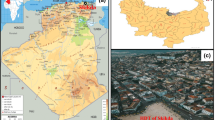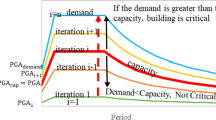Abstract
In destructive earthquakes, embankment seismic damages were widely distributed, and researches on embankment seismic hazard, fragility, and probability risk assessment have important significance to improve highway seismic performance and for regional disaster prevention and mitigation capacities. Embankment seismic damages were divided into five grades, and the maximum lateral permanent displacement rate on the top surface εmax was selected as the embankment seismic damage parameter. Taking the Xi’an–Baoji expressway K1125 + 470 embankment as an example, we carried out a seismic hazard assessment based on CPSHA, a fragility assessment based on IDA and PSDA, and a probability risk assessment based on a hazard curve. On the basis of risk acceptability, a risk management method was put forward, which was suitable for the seismic design of new embankments and seismic strengthening of existing embankments, and verified the positive effect of a retaining wall on the embankment seismic performance. The results show that the seismic hazard assessment results of the Xi’an–Baoji expressway were higher than those of the fourth-generation seismic zoning map; when the PGA reached 0.8 g, the exceedance probability of severe damage was as high as 99.995%; the probability risk of severe damage in the next 50 years was 36.46%. However, the probability risk of severe damage of the embankment with the retaining wall was found to be 21.17%, indicating that a retaining wall can significantly reduce the embankment seismic damage risk. The embankment seismic damage risk was divided into high, medium, and low levels: medium risk and low risk were acceptable, and high risk was unacceptable.










Similar content being viewed by others
References
Alielahi H, Moghadam MR (2017) Fragility curves evaluation for broken-back block quay walls. J Earthq Eng 21(1):1–22
Arabelos DN, Contadakis ME, Vergos G, Spatalas S (2016) Variation of the earth tide-seismicity compliance parameter during the recent seismic activity in Fthiotida, central Greece. Ann Geophys 59(1):S0102
Atkinson GM, Ghofrani H, Assatourians K (2015) Impact of induced seismicity on the evaluation of seismic hazard: some preliminary considerations. Seismol Res Lett 86(3):1009–1021
Bakhtiary E, Gardoni P (2016) Probabilistic seismic demand model and fragility estimates for rocking symmetric blocks. Eng Struct 114:25–34
Bayat M, Daneshjoo F, Nisticò N (2017) The effect of different intensity measures and earthquake directions on the seismic assessment of skewed highway bridges. Earthq Eng Eng Vib 16(1):165–179
Berto L, Saetta A, Simioni P (2012) Structural risk assessment of corroding RC structures under seismic excitation. Constr Build Mater 30(5):803–813
Chen K, Gao MT (2015) Controlling seismic collapse risk of general construction projects in China mainland. J Build Struct 36(1):23–29
Corbane C, Hancilar U, Ehrlich D, Groeve TD (2017) Pan-European seismic risk assessment: a proof of concept using the earthquake loss estimation routine. Bull Earthq Eng 15(3):1–27
Cornell CA (1968) Engineering seismic risk analysis. Bull Seismol Soc Am 58:1583–1606
Cui G, Liu W, Ni S, Wang M, Lin G (2014) Study on different seismic intensities and earthquake damage to highway tunnels in Wenchuan area affected by earthquakes. Mod Tunn Technol 51(6):1–6
Dimova SL, Hirata K (2015) Simplified seismic fragility analysis of structures with two types of friction devices. Earthq Eng Struct Dyn 29(8):1153–1175
Flora A, Lombardi D, Nappa V, Bilotta E (2016) Numerical analyses of the effectiveness of soft barriers into the soil for the mitigation of seismic risk. J Earthq Eng 22:63–93
Ibrion M, Mokhtari M, Parsizadeh F, Nadim F (2015) Timescape of the earthquake disasters in Iran: the intricacies of earthquake time and earthquake disaster risk reduction. Geogr Ann 97(1):197–216
Karthik R, Jamie P, Reginald D (2015) Temporal evolution of seismic fragility curves for concrete box-girder bridges in California. Eng Struct 97:29–46
Kitov IO, Volosov SG, Kishkina SB, Konstantinovskaya NL, Nepeina KS, Nesterkina MA et al (2016) Detection of regional phases of seismic body waves using an array of three-component sensors. Seism Instrum 52(1):19–31
Liu JW, Wang ZM, Xie FR, Lv YJ (2013) Seismic hazard assessment for greater North China from historical intensity observations. Eng Geol 164:117–130
Maruyama Y, Yamazaki F, Mizuno K, Tsuchiya Y, Yogai H (2010) Fragility curves for expressway embankments based on damage datasets after recent earthquakes in Japan. Soil Dyn Earthq Eng 30(11):1158–1167
Melani A, Khare RK, Dhakal RP, Mander JB (2016) Seismic risk assessment of low rise RC frame structure. Structures 5:13–22
Meroni F, Zonno G, Azzaro R, D’Amico S, Tuvè T, Oliveira CS et al (2016) The role of the urban system dysfunction in the assessment of seismic risk in the Mt. Etna area (Italy). Bull Earthq Eng 14(7):1979–2008
Morbin R, Zanini MA, Pellegrino C, Zhang H, Modena C (2015) A probabilistic strategy for seismic assessment and FRP retrofitting of existing bridges. Bull Earthq Eng 13(8):1–18
Poljanšek K, Bono F, Gutiérrez E (2015) Seismic risk assessment of interdependent critical infrastructure systems: the case of European gas and electricity networks. Earthq Eng Struct Dyn 41(1):61–79
Sengupta P, Li B (2016) Seismic fragility assessment of lightly reinforced concrete structural walls. J Earthq Eng 20:809–840
Silva V, Crowley H, Varum H, Rui P (2015) Seismic risk assessment for mainland Portugal. Bull Earthq Eng 13(2):429–457
Tsompanakis Y, Lagaros ND, Psarropoulos PN, Georgopoulos EC (2009) Simulating the seismic response of embankments via artificial neural networks. Adv Eng Softw 40(8):640–651
Vamvatsikos D, Cornell AC (2002) Incremental dynamic analysis. Earthq Eng Struct Dyn 31(3):491–514
Wang QA, Wu Z, Liu S (2012) Seismic fragility analysis of highway bridges considering multi-dimensional performance limit state. Earthq Eng Eng Vib 11(2):185–193
Wu DS, Tesfamariam SF, Stiemer DQ (2012) Seismic fragility assessment of RC frame structure designed according to modern Chinese code for seismic design of buildings. Earthq Eng Eng Vib 11:331–342
Yin C (2015) Study on seismic risk assessment of embankment in plain areas. PhD Thesis, Chang’an University, Xi’an (in Chinese)
Zhang S, Wu Z, Jiang C (2016) The central China north–south seismic belt: seismicity, ergodicity, and five-year pi forecast in testing. Pure Appl Geophys 173(1):245–254
Acknowledgements
This study is supported by the National Natural Science Foundation of China (Grant No. 51608313), Natural Science Foundation of Shandong Province (Grant No. 2015ZRB019JS), and Doctor’s Research Launching Program of Shandong University of Technology (Grant No. 415046).
Author information
Authors and Affiliations
Corresponding author
Rights and permissions
About this article
Cite this article
Yin, C., Li, Y. & Liu, Ff. Probability Risk Assessment and Management of Embankment Seismic Damages Based on CPSHA-PSDA. Iran J Sci Technol Trans Sci 43, 1563–1574 (2019). https://doi.org/10.1007/s40995-018-0630-9
Received:
Accepted:
Published:
Issue Date:
DOI: https://doi.org/10.1007/s40995-018-0630-9




